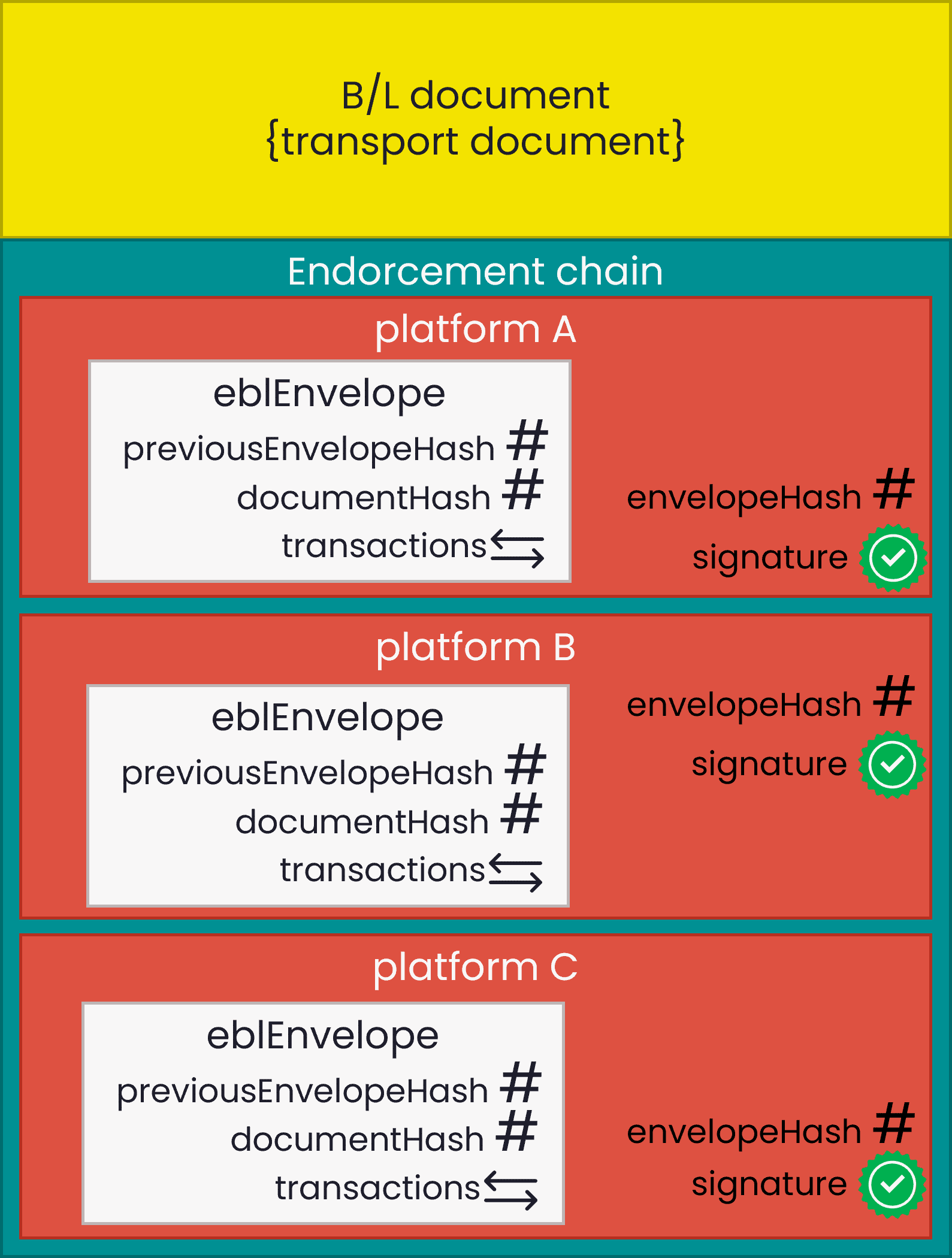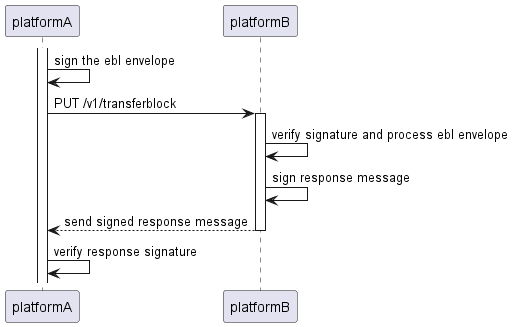This document provides the technical description and specifications for transferring eBL documents between platforms using the eBL Envelope. General concepts and backgrounds can be found here. the rendered Open API specification for the is available on the DCSA Swaggerhub. However, for easier collaboration and the ability to add PR's and issues the resolved oas specification can be found in here.
- sha256 of the json structure is fragile. sha256 of base64 encoding is more robust (same goes for all hashes)
- should the transportdocument be sent in a separate json document and the API has the mime type that supports this?
- response of the PUT transferblock is an encoded JWS with the eblEnvelopeHash signed by the receiving platform.
- response of the PUT transferblock is only the string representation of the encoded JWS (no wrapper JSON object)
- transferee is represented with the DCSA Party object
- discuss the details of platform authentication OIDC and if further specifications are required
- align on the standardized error responses
| Date | Decision |
|---|---|
| 20-07-2022 | In the initial version title and possession will be combined (=control) and transferred simultaneously |
| 20-07-2022 | Identity is transferred with internal Identifier of the platform + Platform domain (/name of platform). Formatted as an email address localid@platform.io |
See the contributing guide for detailed instructions on how to get started with our project.
Transferring the BL control (Possession & Title) is accomplished by sending a "Transferblock" from the sending platform to the receiving platform.
A transferblock is a single JSON structure described here. The transferblock has the following structure:
- data of the B/L according to the DCSA transportDocument specification
- The complete endorsement chain as signed eblEnvelopes transferred between platforms
- signature of the eblEnvelope - signed with the private key of the sending platform
- sha256 hash of the eblEnvelope
- eblEnvelope
- sha256 hash of the previous eblEnvelope
- sha256 hash of the B/L data
- list of transactions that are exported and shared between platforms
Which is depicted in this diagram:

Information regarding the B/L control (possession + title) is transferred into the EBL envelope. This envelope is signed by the sending platform.
The EBL envelope contains:
- the list of transactions that are transerred to another platform
- the hash of the B/L information (transportdocument)
- the hash of the previous ebl envelope (null if this is the first cross-platform transfer)
the EBL envelope itself is signed by the sending platform. This signature and the hash of the EBL envelope are transferred alongside with the EBL envelope so the receiving party can verify the received EBL envelope.
A transaction inside the eblEnvelope are the representation of the transfer of control (possession + title). Each transaction inside the transactions (list) of the EBL envelope consists of:
- instruction - instruction for processing the transaction: ISSU (Issue), TRNS (Transfer), SURR (Surrender), AMND (Ammend), SW2P (Switch to Paper)
- comments - free text comment for the party receiving the transaction
- timestamp - Unix epoch with millisecond precision of when the transaction was created
- isToOrder - indicator if the B/L is to order
- platformHost - base url of the platform which created the transaction
- transferee - Identity information about the party which controlled is transferred to see Identity below
This results in the following JSON structure:
{
"endorcementChain": [
{
"envelopeHash": "20a0257b313ae08417e07f6555c4ec829a512c083f3ead16b41158018a22abe9",
"signature": "eyJhbGciOiJSUzI1NiIsImtpZCI6IlVhRVdLNmt2ZkRITzNZT2NwUGl2M1RCT2JQTzk2SFZhR2U0czFhUUxBZU0ifQ.eyJkb2N1bWVudEhhc2giOiJmZDg2OGM4MmU5OTc3N2I0NzJhMTY3NzM5MGQ5NTRkYmIwMTMxY2IzYjBmNTVjOGVmNTE5Njk4NTY0MTBkMzhlIiwicHJldmlvdXNFbnZlbG9wZUhhc2giOm51bGwsInRyYW5zYWN0aW9ucyI6W3siaW5zdHJ1Y3Rpb24iOiJJU1NVIiwiY29tbWVudHMiOiJUaGUgQi9MIGhhcyBiZWVuIGlzc3VlZC4iLCJ0aW1lc3RhbXAiOjE2NTgzODUxNjYzMDI0NDIyMDAsImlzVG9PcmRlciI6dHJ1ZSwicGxhdGZvcm1Ib3N0IjoibG9jYWxob3N0Ojg0NDMiLCJ0cmFuc2ZlcmVlIjoiNDM1NDk4NTAyNDhAbG9jYWxob3N0Ojg0NDMifV19.aybAB3RUg_UM2WcvoE4s807Kf7BhSALZq1EvF9f_AUP6ZZgOP4cFS0rlLHSVrobKlF_Og-w0K_M9SPAQS6UnY0hht6pwHTHmoxPmWoQ-ARhnsThjhB3ZYhDbrroJnYPkQAjCmKXPrhNi2z9Fn4GvaI6iRjfJMQchSWQtAEjhqSLNaHtRwec65CDYEZ6OTHX7uP5g3WZtCfmswRGrkcCLosveSxsFpezjjOfTEo2NCCtO0tAxtNtus4GsF8QIMrM6QknJ4909ZrVonvtMUoRffFoUqgemfaFggK5XriLgn2OdSn8ZBhRn_ZqVojuf26mXrVm12C9jSQPPfPGy-myrOQ"
}
]
}Transferring a B/L between platforms consists of creating and signing the ebl Envelope and wrap it in a transferblock. This transferblock is being send via a HTTP PUT to the receiving platform. Which is depicted in this diagram:
The transfer operation: PUT /v1/transferblock is a synchronous operation. The the transactional integrity is maintained by the client.
In order to verify the transfer has been successful and the integrity of the message is maintained the response message is signed by the receiving party and verified by the sending party. For more information about both the request and response signatures see the Signatures paragraph below
In order to transfer the B/L to another platform identity information of the receiving party, the transferee, must be known to the sending platform. The exchange of identities between users of platforms is out of scope for this reference implementation. Next to exchanging the identities the identities must be formatted in a manner understandable and sharable between various platforms.
All transferee identity information is exchanged with an eBLPlatformIdentifier in combination with the DCSA Party object.
The eBLPlatformIdentifier is a combination of the transferee user identification on the local platform and the platform. EBLPLatformIdentifiers are formatted similar to email addresses: localid@platformdomain.ext for example: gV2ZDy0jmae7@dcsaebplatform.org In this example gV2ZDy0jmae7 is the local identifier on the fictitious dcsaebplatform.org
While the eBLPlatformIdentifier is required, it is optional but recommended for providing additional identity information regarding the transferee. This additional information can be used by the receiving platform to perform additional verification. For providing this additional information the DCSA Party object is used. The DCSA Party object allows of the provision of LEI, tax reference and DID and many others documented in the DCSA Party object.
The platform domain part of the eBLPLatformIdentifier being a resolvable domain name can be used for DNS based service discovery. With this an additional TXT record can be created linking to the API endpoint providing the PUT /v1/transferblock operation.
Example: dcsaeblplatform.org can link to a TXT record containing the full API endpoint -> api.dcsaeblplatform.org/v1/transferblocks
Security on the transport level requires:
- mTLS
- TLSv1.2 or TLSv1.3
- When using TLSv1.2 only Cipher suites that support perfect forward secrecy
TLSv1.3 mandates perfect forward secrecy, when using TLSv1.2 this means the usage of the following cipher suites:
- TLS_ECDHE_RSA_WITH_AES128_GCM_SHA256
- TLS_ECDHE_RSA_WITH_AES256_GCM_SHA384
- TLS_ECDHE_RSA_WITH_AES256_CBC_SHA384
Authentication between platforms require:
- OIDC
- Client credentials grant flow
The signatures used in the transfer of the B/L accross platforms have the following characteristics: for the request message:
- signature covers the eblEnvelope json structure
- signature is created using the private key of the sending platform
- the signature is transferred as a JWS (Json Web Signature as described in RFC 7515) in the signature field
- the JWS is tranferred in the compact serialization format (as described in Section 7 of RFC 7515)
For the response message:
- signature covers the envelopeHash of the last item in the endorcement chain
- signature is created using the private key of the receiving platform
- the signature is transferred as a JWS (Json Web Signature as described in RFC 7515) response body
- the JWS is tranferred in the compact serialization format (as described in Section 7 of RFC 7515)
Digital certificate standards are a balance between information security, ease of adoption, and cost. To sign an eBL envelope with a private key of a digital certificate, the following technical minimum requirements MUST be met to guarantee trustworthy eBL envelopes:
| Category | Standard |
|---|---|
| Certificate format | X.509 (https://www.itu.int/rec/T-REC-X.509) |
| Minimum requirements signature algorithm | SHA256withRSA or SHA256withECDSA |
| Minimum key length for signatures | 2048-bit RSA or 256-bit ECDSA |
| Certificate revocation information method | OCSP (IETF RFC 6960) |
| Certificate validity period | Maximum of 2 years (validity MUST be part of the certificate) |
| Signature format | See above in the Signatures section |
| Archive period (for certificates & signatures) | Minimum of 10 Years for both sender and receiver of signed documents |
